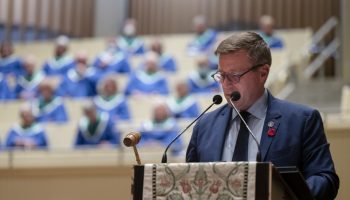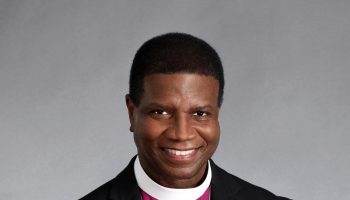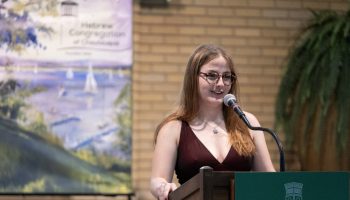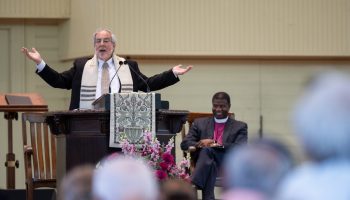“Job was a man beset by suffering, sorrow and sickness. We see him as he tries his best to push through the pain and see a way through. Sometimes it is hard to get through the gloom and darkness and not let the gloom get inside you,” said the Rev. Raphael Warnock at the 9:15 a.m. Friday morning worship service. The title for his concluding sermon of the week was “Lessons From a Tree,” and the Scripture reading was Job 14:7-12,14.
“Job is a model of suffering and he never loses hope. Some people think he is a paragon of patience, but they have not read the book. He argues with God. I have arguments with God sometimes,” Warnock said. “Job wrestles with God but does not lose hope. [The word] ‘hope’ appears 11 times, more than any other book of the Bible.”
“Suffering leads to endurance, and endurance leads to character, and character leads to hope, which does not disappoint,” he said.
Job never lost hope despite his friends.
“They were theologs who exercised the privilege to wax eloquent while Job writhed in pain,” Warnock said.
They told Job he was suffering because of his own sin; his suffering must be his own fault. Job felt worse after talking to his friends.
“Have you ever sat with a friend, expecting constructive feedback, an intelligent interlocutor, and found you would be better off talking to a tree?” Warnock said.
As Job surveyed the wreckage of his life, his eyes lit upon a tree that seemed to be saying, “Sit in my shade and talk with me.” Warnock quoted the poem “Trees” by Joyce Kilmer beginning with, “I think I shall never see a poem as lovely as a tree,” and ending with, “A poem is made by fools like me, but only God can make a tree.”
“I have been preaching all week and at the end of the week we need tree-ology,” Warnock said.
Warnock and his wife honeymooned in Kenya and he was awed by the baobab trees. They provide nurture, medicine and nourishment. The elders gather under them. There is an African saying: “A tree never forgets its roots.”
“We need tree-ology to inform our theology. Now, you might ask where do you find that in the Bible? Look at Psalm 1,” he said. “I don’t know much about the cedars of Lebanon, but I know the great old oak trees of Savannah. They are centuries old and with Spanish moss hanging from them, they look like gray-bearded old men.”
“What lesson to they offer?” he said. “They were there when the first black folk arrived on ships and were sold under their branches. They were there when Billie Holiday and Nina Simone sung about strange fruit hanging from Southern trees, blood on the leaves and blood at the roots. They were there when the steam engine and the electric car came and they survived a hurricane that happened when I was 9.”
“Mr. Tree,” Warnock said, “why do you still stand?”
The tree said: “My roots go down deep in the soil. It is impressive to see how they look deep, down under. Our roots are long and strong but we can withstand a storm because they are wrapped around each other and when the storm pulls on one tree, the other pulls it back. Also, we are planted next to a river, so we have a reservoir in the dry season.”
Warnock said Job was transfixed by the tree. Its roots grew deep in the Earth and its stump died, but at the scent of water in the air, it would bud and put forth branches again.
“This verse blows my mind. At just the scent of water, it can live again,” Warnock said. “What can be more subtle? It doesn’t take a flood, just a little bit of hope in the air.”
Mortals, on the other hand, die and are dead.
“From the least to the greatest, they all die. But even the greatest of all time offered lessons from a tree,” he said. “Jesus was nailed to a tree and said, ‘Father forgive them.’ Lessons from a tree. Jesus said, ‘No one can take my life; I offer it freely.’ Lessons from a tree. Jesus said, ‘I commend my spirit [to heaven].’ Lessons from a tree.”
A man dies on a tree and is just dead, not aroused by the scent of water, “unless he is the water, unless he is the living water, the life-giving water. If he is the living water, the women will come to embalm him and he will not be there. By the perfume of his own authority, he defeated death. I am glad Jesus is the answer to Job’s questions,” Warnock said.
“My mother is from Waycross, Georgia; she is a country girl and can make anything grow,” he said. “I thought a plant was dead until I gave it to my mother. She has the right touch; she will talk to a plant until it comes back to life. She knows how to break a plant and give it to someone else and start a new thing. She knows just where and when to break it and it starts a whole new thing. She multiplies the plant’s influence. The plant is more powerful once it is broken; it creates another and another and another.”
Some things will leave you broken, he said, but your brokenness does not leave you useless.
“God uses our brokenness to multiply our influence and uses broken people to bless others. Breaking is an end and a beginning. Don’t be so focused on the end that you can’t embrace what God is getting started.” he said. “There is water nearby, living water. Can you sense, imagine, embrace, smell it? I will tiptoe toward the sun and take my roots and reach for water. No matter how broken I am, I can be made whole. Praise be unto God.”
The Rev. George Wirth presided. Elizabeth Waters, a scholarship student with the International Order of King’s Daughters and Sons from Vienna, West Virginia, read the Scripture. Waters will be a sophomore at West Virginia University. The Motet Choir performed “Sing We Merrily unto God our Strength” by Sidney Campbell. Jared Jacobsen, organist and coordinator of worship and sacred music, directed the choir and playing the Massey Memorial Organ. The Samuel M. and Mary E. Hazlett Memorial Fund supported this week’s services.





